Fleas are an extremely common problem in dogs. The Big Flea Project in the UK in 2018 found that 14% of dogs were infested with fleas. Fleas can affect dogs of all ages.
If caught early, fleas can be easy to get rid of. If left untreated, it can take longer to get rid of fleas and dogs can develop severe skin problems. There are products available to protect your dog against fleas if they’re used regularly.
Overview
What are fleas in dogs?
Fleas are very common parasites that live on the skin of dogs and in the household. They are small, dark, and oval in shape.
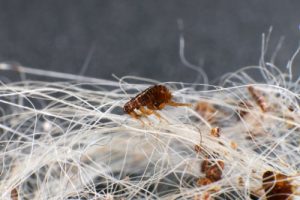
How do dogs get fleas?
- Dogs catch fleas through direct contact with other animals, including cats, and even wildlife. Fleas can spread indirectly through grass, clothing, footwear, and bedding. They can jump long distances too.
- Adult fleas survive by feeding on blood. This can lead to serious anaemia if there are a large number of fleas. This is more common in very young and older animals.
- Fleas can carry tapeworms and other diseases. Find out more about Worms in dogs
- Fleas are more common in the summer but can be present all year round.
- The lifecycle of a flea involves eggs, larvae, pupae, and adult stages. In some environments, it can take only 15 days from the egg to the adult stage, so they can grow quickly in numbers.
- Adult fleas are mostly found on the skin surface of our pets. Eggs, larvae, and pupae are found in the environment, such as deep in carpets, crevices, or furnishings. They can survive for years in the right conditions.
- Dogs can develop allergies to fleas; even one bite can cause a severe skin reaction. This is called Flea Allergy Dermatitis in Dogs
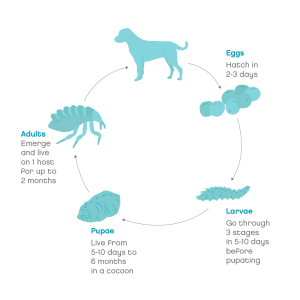
Flea infestations can be extremely difficult to get rid of. Prevention of fleas is much better than treatment, as treatment can be frustrating, expensive, and often takes months.
Symptoms
Symptoms of fleas in dogs
How to tell if your dog has fleas
- Some dogs may not show any signs of fleas at all.
- Some show signs of itching, scratching, biting, and licking.
- Hair loss, especially on the back and top of the tail.
- Skin sores, such as red spots and dry skin. Also known as flea allergy dermatitis.
- Black spots on your dog’s coat or bedding. This is called fleas dirt.
- Low energy and weakness
- Pale gums, especially in very young and older animals. This is due to anaemia, which means a reduced amount of red blood cells in the body. This can be extremely serious, even leading to death.
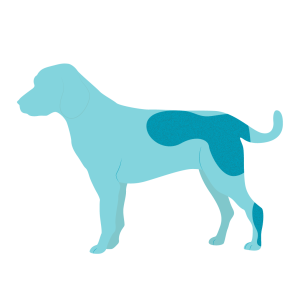
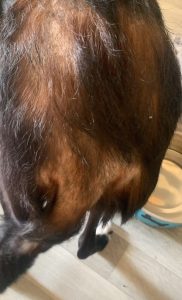
Risk
Are some dogs more at risk of fleas than others?
Dogs of any age, breed, or sex are at risk of fleas.
- Fleas may be more difficult to spot in dogs with longer, heavier, or darker coats.
- Because they spread so quickly, sociable dogs are more at risk of catching fleas.
- If one of your pets catches fleas, there is an extremely high risk that all other pets in the household will also have them.
Is my family at risk of catching fleas?
- Cat and dog fleas can bite humans, but they don’t live on our skin.
- Flea bites on humans often appear as a red spot or scab.
- These can become itchy and infected.
- We recommend speaking with a pharmacist or doctor about how to treat this.
Diagnosis
How are fleas diagnosed in dogs?
The diagnosis of fleas is usually straightforward. It may be done at home, though it’s often best to get a professional to check if you are unsure.
- Fleas are usually diagnosed by finding live adults or flea dirt (flea faeces) on the coat.
- Check the thinner-haired areas, such as the inner thighs or tummy, for adult fleas. They move very quickly, so they may be difficult to spot.
- A paper test can be used to check for flea dirt. Brush your dog using a flea comb onto a sheet of white paper or paper cloth. Flea dirt looks like small black specks. Apply a few spots of water, and they will leave red marks on the paper.
- Fleas may also be suspected based on the symptoms. Itching and the pattern of hair loss or skin sores can suggest fleas.
- There are many other causes of itching in dogs; it’s best to speak to a veterinarian if your pet is showing these symptoms and there are no signs of fleas. Have a read of our article Itchy dogs.
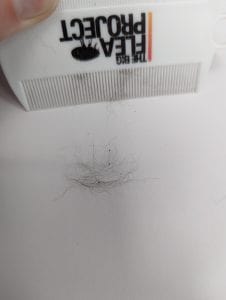
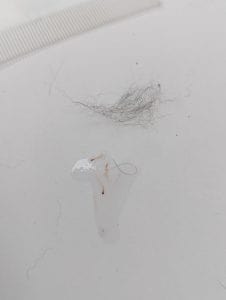
If your dog has hair loss or skin lesions, your vet may recommend the following tests to check for other skin diseases
- Skin scrapes, hair plucks, and a skin biopsy
- A diet trial
- Blood and urine tests
Vet treatment
What’s the treatment for fleas in dogs?
Treatment for fleas is aimed at killing the adults on your pet and eliminating any other stages in the household. Dogs with severe itching, skin lesions, or flea allergies may need prescription medication to get better.
Treat all of the pets in the household with a vet-recommended product.
- Speak to a vet before applying any products; some may be toxic to different animals. https://www.vpisglobal.com/common-poisons/
- Make sure to use the correct product based on your pet’s weight.
- Repeat these regularly, as advised by your vet. This is mostly every 4 weeks, but some are every 3 months.
- Prescription medications that kill fleas include spot-ons and oral treatments.
- Some over-the-counter flea products are effective at treating and preventing fleas. These come as a spot-on or collar.
- If using a spot-on treatment, do not bathe or let your pet out in heavy rain for at least 48 hours, as this can reduce the effectiveness of the medication.
- Flea shampoos, powders, and herbal remedies are often not effective at killing fleas. Especially as long-term solutions. They may also contain toxic substances.
- Fleas can carry tapeworms. It’s important to treat your dog for tapeworms regularly, especially if they have been diagnosed with fleas. Tapeworm preventative and treatment is available over the counter and on prescription.
If your pet has hair loss, severe itching, skin lesions, or flea bite allergies
- Your vet may dispense prescription anti-itch medications.
- Antibiotics in tablets, injections, or topical forms for secondary skin infections.
Home treatment
How to get rid of fleas from the household
95% of fleas live in the environment, so treating the home is an extremely important step.
It can take a few months to get rid of a flea infestation. The best advice is to follow the recommended guidelines and be consistent with treatments.
Treat the household and car with a vet-recommended product.
- The environment usually needs more than one treatment, as the next flea cycle emerges after 2-3 weeks.
- Household sprays that kill the adult fleas and prevent egg and larvae development tend to be the most effective.
Wash all bedding and vacuum regularly
- Hot wash (over 60℃) all bedding your dog has been in contact with and clothing that has been on the floor.
- A dry cycle is also recommended.
- Vacuum the whole house.
For dogs with skin lesions, hair loss, or itching
- For very itchy pets, see a vet for prescription anti-itch medication.
- Use a calming shampoo or mousse for mild skin irritations.
- Use a buster collar or pet medical suit to prevent self-trauma.
- Skin supplements containing omega oils can be useful for irritated and itchy skin.
Prevention
Tips on how to prevent fleas in dogs
Prevention is much easier and less expensive than treatment.
- Use a recommended flea-preventative product all year round, even if your pet is not in contact with other animals. These are usually applied monthly, but some products may last longer.
- Groom and brush your dog regularly to check for anything abnormal in their fur or on the skin.
- Vacuum regularly, and put your dog’s bedding in a hot wash cycle.
- Use a household spray regularly that kills fleas; these often last 6-12 months.
- Limit contact with stray or unknown animals who may not be on regular flea control.
- If you have a garden, mow the grass regularly and prevent access to wild animals.
When to worry
What to do if you are worried about fleas
Seek help from a vet if
- Your dog is constantly itching or scratching.
- Your dog has a lot of hair loss or widespread skin lesions.
- You have a young or old dog with fleas, and they are lethargic.
Joii can help if
- Your dog has any minor skin problems or itching.
- Your dog has been diagnosed with fleas, and you need advice on treating the house.
- You want to know more about flea prevention in dogs and how to apply it.
- You want to know how to check your dog for fleas.
- You need tips on how to brush your dog.








